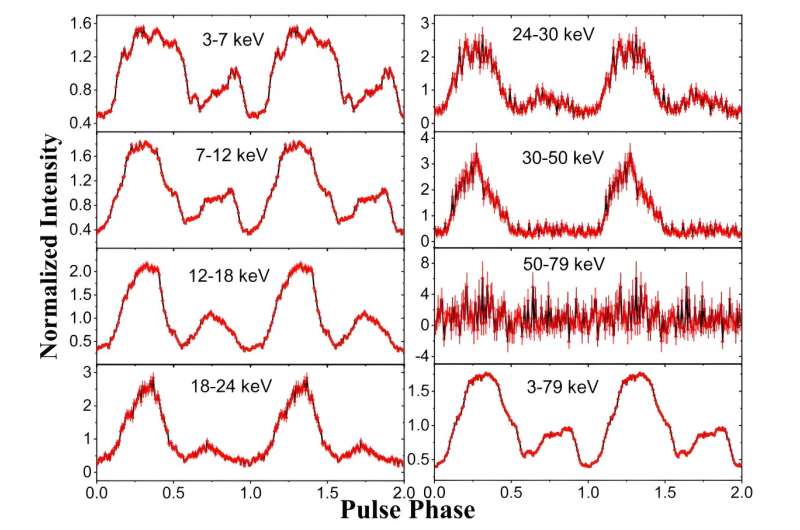October 10, 2023 report
This article has been reviewed according to Science X's editorial process and policies. Editors have highlighted the following attributes while ensuring the content's credibility:
fact-checked
peer-reviewed publication
trusted source
proofread
Eclipsing X-ray binary 4U 1538-522 investigated with NuSTAR

Using NASA's Nuclear Spectroscopic Telescope Array (NuSTAR), Indian astronomers have observed an eclipsing X-ray binary system known as 4U 1538-522. Results of the observational campaign, published September 26 in the Monthly Notices of the Royal Astronomical Society journal, deliver important insights into the properties and behavior of this pulsar.
In general, X-ray binaries (XRBs) are systems composed of a normal star or a white dwarf transferring mass onto a compact object, which may be either a neutron star or a black hole. Based on the mass of the companion star, XRBs are further divided into low-mass X-ray binaries (LMXBs) and high-mass X-ray binaries (HMXBs).
4U 1538-522 is a wind-fed persistent eclipsing HMXB at a distance of about 22,200 light years. In this system, a neutron star accretes from the stellar wind of a supergiant star (with a mass of some 17 solar masses), which it orbits every 3.73 days with regular eclipses. Previous observations have found that 4U 1538-522 has a spin period of 528.93 seconds and has an X-ray luminosity at a level of 2.0 undecillion erg/s.
Now, a team of astronomers led by Ruchi Tamang of the North Bengal University in Siliguri, India, have employed NuSTAR in order to further investigate the properties of 4U 1538-522.
"In this paper, we present the detailed spectral and timing analysis of the source 4U 1538-522 using NuSTAR observations," the researchers wrote.
The observations found that the spin period of 4U 1538-522 is approximately 526.23 seconds. The system was found to exhibit a spin-down trend at the rate of 0.163 seconds per year until a torque reversal occurred, followed by the spinning up of the source at the rate of -0.305 seconds per year.
According to the study, the pulse profile of 4U 1538-522 resembles a double-peaked nature with primary and secondary peak. The secondary peak was found to become weaker near cyclotron line energy (energy band 18-24 keV). NuSTAR data show that the pulse profile exhibits a transition from double-peaked to single-peaked nature above 30 keV.
During the observations the cyclotron line energy of 4U 1538-522 was initially found to increase at a rate of about 0.11 keV per year, and afterward a decrease was identified at a rate of -0.14 keV per year. The astronomers noted that the variation in the cyclotron line energy may be due to an imbalance between the inflow and outflow of the material, which causes a change in the accretion mound with time.
NuSTAR observations regarding the eclipses of 4U 1538-522 suggest that the wind in the system is composed of small, dense clumps. The authors of the paper concluded that these clumps shadow the light of sight when the neutron star enters into the limb of its supergiant companion.
More information: Ruchi Tamang et al, Long-term evolution of Cyclotron Line energy in an eclipsing pulsar 4U 1538-522., Monthly Notices of the Royal Astronomical Society (2023). DOI: 10.1093/mnras/stad2907. On arXiv: DOI: 10.48550/arxiv.2309.17013
Journal information: arXiv , Monthly Notices of the Royal Astronomical Society
© 2023 Science X Network




















